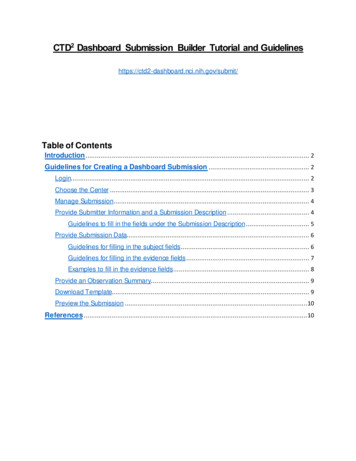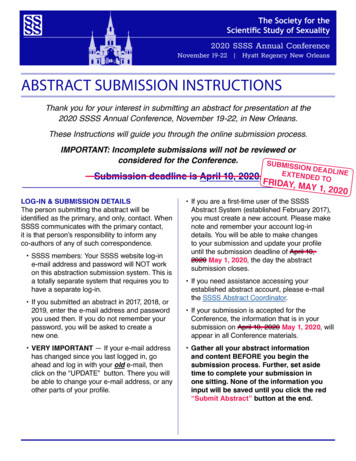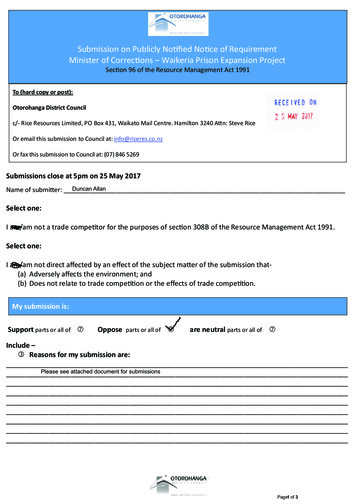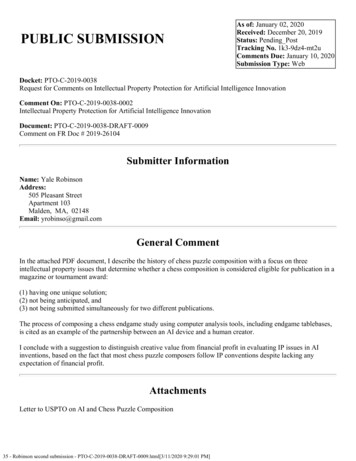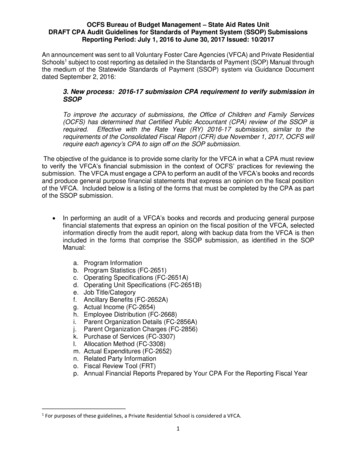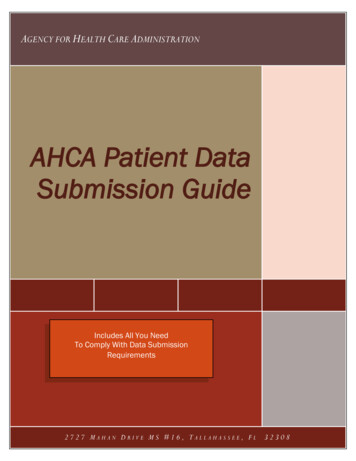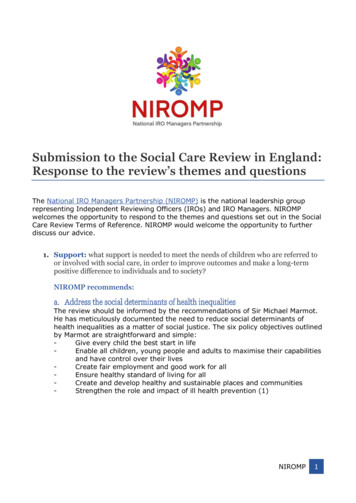
Transcription
Submission to the Social Care Review in England:Response to the review’s themes and questionsThe National IRO Managers Partnership (NIROMP) is the national leadership grouprepresenting Independent Reviewing Officers (IROs) and IRO Managers. NIROMPwelcomes the opportunity to respond to the themes and questions set out in the SocialCare Review Terms of Reference. NIROMP would welcome the opportunity to furtherdiscuss our advice.1. Support: what support is needed to meet the needs of children who are referred toor involved with social care, in order to improve outcomes and make a long-termpositive difference to individuals and to society?NIROMP recommends:a. Address the social determinants of health inequalitiesThe review should be informed by the recommendations of Sir Michael Marmot.He has meticulously documented the need to reduce social determinants ofhealth inequalities as a matter of social justice. The six policy objectives outlinedby Marmot are straightforward and simple:Give every child the best start in lifeEnable all children, young people and adults to maximise their capabilitiesand have control over their livesCreate fair employment and good work for allEnsure healthy standard of living for allCreate and develop healthy and sustainable places and communitiesStrengthen the role and impact of ill health prevention (1)NIROMP1
2. Strengthening families: what can be done so that children are supported to staysafely and thrive with their families, to ensure the exceptional powers that are granted tothe state to support and intervene in families are consistently used responsibly,balancing the need to protect children with the right to family life, avoiding the need toenter care?NIROMP recommends:a. Learn and take a lead from people with lived experienceA whole system approach to inclusion, co-construction, and participation mustbe better understood and implemented. We see this as a major area for focusedlearning, development, and system change.IROs will continue to call for leaders and advisors with influence over guidanceand legislation to listen to the voice of those with a lived experience of the careand welfare system. We are committed to creating connections with people andusing the impact of our role to improve services for children in care and careleavers; we work in partnership and if children and families need a voice wespeak up and act.b. Introduce a social model of wellbeingWe want to see sharp focus given to a social model of wellbeing and creating thebuilding blocks for increased community resilience. Social and economicinvestment alongside cultural change and a sharing of power is needed. Nationaland local policy objectives should integrate a golden thread of kindness;mutuality; and relationships promoted through a language that both respectsand appreciates reciprocal power and the strengths and agency available withinand across different communities (2).c. Create a joined-up approach to keep families togetherFor lives and futures to change, there should be a refocused investment inhelping families stay together safely and happily. The wider societaldeterminants that support family wellbeing should be prioritised. A coherentstrategy to support joined-up approaches to social welfare including, forexample, the determinants of income, employment, housing, school inclusion,and poverty in all its forms (health, digital, economic, educational, cultural, andsocial) is required.By tackling the wider societal determinants of inequality and inequity, we shouldin time see significantly enhanced family and community wellbeing, prosperity,and resilience. Getting care right is not only a matter for social care; the issuesare intersectoral and cross-government. Therefore, positive reform demandsjoined-up solutions and a whole-system approach.NIROMP2
3. Safety: what can be done so that children who need to be in care get there quickly, andto ensure those children feel safe and are not at risk of significant harm?NIROMP recommends:a. Revisit how child protection is conceptualised and managedThe Children Acts of 1989 and 2004 aimed to improve services for children bypromoting family support and help. There should be a move away from‘muscular authoritarianismi’ (3) in favour of help, compassion, respect, andrecognition of the strengths and assets available within families andcommunities. And where permanence for children cannot be secured withinfamily networks, swift and skilful practice must lead to court action without delaybut in all other circumstances court should be avoided.The ADCS Safeguarding Pressures Phase 7 shows poverty has a significantdeterminant on factors such as parental mental ill health, domestic abuse,parental substance misuse and child neglect (4). As well as investing incommunity based universal services for lower level need, families must haveaccess to sufficient and effective services for higher level need based on a moresophisticated understanding of support provision (5).Shared care and work with family and friendship networks should be developedand incentivised, so that where safety allows, parents and extended family inpartnership with support services, are fully enabled to care for children with helpfrom their own family networks.There should be deeper listening and learning from people who have livedexperience of the social care system. Children, families, and the workforce needthe scaffolding of help, support, and accountability necessary to cultivate trustand a different type of conversation. People who are experiencing multipledisadvantages need to be listened to but more than that, they need to be seenand treated as equal partners and this should filter through to the principlesinforming service design, delivery, regulation and inspection.Services need to develop ways to get alongside and build trust with families, togenuinely understand what matters to them, listening with purpose and humilityto make a difference through a different type of relationship that is morereciprocal. There must be sufficient social work skill, curiosity, organisationalcapacity, capability, and support services to effectively build helpingrelationships over time. And senior leaders must create the cultural and operantconditions necessary to bolster professional judgement. For a cultural shift tohappen, people in leadership and professional positions need to be brave enoughto challenge, to listen, to try different approaches, to make and learn frommistakes, and to have the humility to share power.b. Build the infrastructure to support parent and child participation and advocacyPromoting parent and child participation is central to achieving children’s rights.A review by the Better Care Network and the International Parent AdvocacyNetwork (IPAN) shows the importance of the role of parent advocacy inachieving better outcomes of children and their families in child welfare, andprovides encouragement to parents and their allies to work together toNIROMP3
transform child welfare systems (6). Positive change demands that parents aswell as children with lived experience of child welfare systems have an increasedrole and influence in the development of better social care systems.c. Build on good practice to support improvements to mental healthNational policies require effective local delivery systems that give value andemphasis to mental health and wellbeing. The South East Clinical Review andPractice Guide for all staff working with Children in Care, provides a practicaloverview of best evidenced practice in recognising, understanding, andsupporting the improved emotional wellbeing of our Children in Care. The guidewill be rolled out nationally. It is a good example of multi-disciplinary and multiagency collaboration to improve the effectiveness of delivery systems (7).4. Care: what is needed for children to have a positive experience of care that prioritisesstability, providing an alternative long-term family for children who need it and support forothers to return home safely?NIROMP recommends:a. Extend the ban on the use of unregulated accommodationThe ban that comes into effect this September will require all 16 and 17 yearolds to be placed in a setting that guarantees them ‘care’. But, this leaves 16and 17 year olds vulnerable to being placed in accommodation that is preventedby law from providing care. The ban on unregulated care should be extended toinclude 16 and 17 year olds. National policy should promote and support thelanguage and principles of ‘Care’ irrespective of age. Regulatory reform isessential in addressing the issues and improving standards for all children incare. No child should be placed in unsafe, unsuitable accommodation and themessaging of social care policy should endorse ‘care for all’.b. End all profiteering from the care of vulnerable children in careThe examination by the Competition and Markets Authority into whether profitsfor private providers are coming at the expense of quality of care is to bewelcomed. The motive for operating and providing care for children should bequality and sustainability, not profit, which in itself, changes the dynamic of whyand how care is provided and includes influence on provision not solely focusedon the needs of the child. Private companies should not be able to generatesignificant profits on the back of vulnerable children. Systems for providing caremust be driven by children’s needs, not maximising profits.NIROMP4
5. Delivery: what are the key enablers to implement the review and raise standards acrossEngland, such as a strong, stable and resilient workforce, system leadership andpartnerships, and what is needed so that this change can be delivered?NIROMP recommends:a. Explicitly address Racial and Ethnic DisparitiesProfessional institutions cannot maximise social justice and human wellbeingwithout advocating to reform the racist and oppressive systems that socialworkers still work within and beside (9). The Social Care Review should fullyconsider the role of racism and ethnic disparities within institutions and systemsthat have affected social care for generations.Explicit attention should be given to anti-discriminatory, anti-oppressiveand anti-racist practice in the Social Work England Education and TrainingStandards. The review should consider why social work institutions havecontinued to regulate Black, Brown, and ethnic minoritised social workers morerigorously (10).IROs and their managers have an ethical duty to oppose racism, both personallyand professionally, and to demonstrate what it means to be anti-racist alongwith wider public servants; directly confronting racism at the individual, agency,and institutional levels. We should be held accountable to this anti-racistmandate (11).NIROMP rejects the conclusion of the report by the Commission on Race andEthnic Disparities (Cred) (12). The Cred report denies the extent and effects ofinstitutional racism in the UK. In contrast to the landmark inquiry into the deathof Stephen Lawrence (13); the Lammy Review (14); the McGregor-Smith Review(15), the Cred report was not peer reviewed and has been extensivelydiscredited by health professionals (16), academics (17), business chiefs(18) and criminal justice experts (19).There exists a plethora of quantitative and qualitative data evidencinginstitutional racism. The evidences includes but is not exhaustive to the Covid-19Marmot Review (20), the Runnymede Trust (21), the Resolution Foundation(22), and the Equality and Human Rights Commission (23) documenting theexistence of ‘lived’ racisms and racialisations endured by individuals in the UKtoday across most sectors of industry as well as academia, education, thehealthcare system and the criminal justice system.NIROMP could document many more examples of credible evidence. Theknowledge base that exists on the extent and effects of racism and the impact inthe UK, particularly on the educational outcomes and life chances of youngpeople from racial / ethnic minoritised backgrounds which includes childrencurrently living in the care system and those with experience of living in the caresystem is undeniable.NIROMP5
b. Introduce a more inclusive education systemThere must be effective measures to end the systematic exclusions andinequalities in secondary and higher education. Digital poverty must beaddressed (1) (24) and more must be done to address what campaigners arereferring to as the ‘PRU-to-prison’ pipeline (25). Financial and pastoral resourcesshould support everyone to reach their potential. The creation of a tertiaryeducation system that enables all learners to access different types of learningthroughout their lives is needed.c. Implement the recommendations of the Public Law Working GroupThe recommendations of the Public Law Working Group (PLWG) addressconcerns about the impact of proceedings on the growing number of familiesinvolved, as well as increasing workload pressures on social workers, lawyersand judges. Longer term, the report recommends extending the role ofindependent reviewing officers (IROs) and conference chairs to offer additionaloversight outside of proceedings to aid more consistent decision-making,prevent drift in pre-proceedings and help promote the voice of the child. This isto be broadly welcomed so long as IRO workloads are manageable.6. Sustainability: what is the most sustainable and cost-effective way of deliveringservices, including high-cost services, who is best placed to deliver them, and how could thisbe improved so that they are fit for the future?NIROMP recommends:a. Return to the principles of the Equality Act 2010Recent review carried out by researchers at the University of Bristol (26) foundthat there are some protected characteristics that are associated with anincreased risk of poverty in the UK: race, sex (in the case of single mothers),and disability. In relation to age, younger workers are much more likely to be inpoverty than other age groups. They also found that intersectionality plays alarge role; the more protected characteristics a person has, the more risk theybear including increased likelihood of incurring poverty premiums, evencompared with low-income households as a whole.There should be a commitment across all public bodies to attend to the socioeconomic inequalities as much as personal ones. Considering the inequality laidbare by Covid, this should be the opportunity to start taking measures toaddress the social determinants of poverty on an intersectoral basis (27) (20).Action should therefore attend to the original intention of the Equality Act 2010(28), recognising intersectional disadvantage, would help to address prevailinginequalities.NIROMP urges the review to consider the need for a national equity-based planand long-term investment to address the range of complex, health and welfaredisparities demands the building of partnerships across sectors, industries,communities, and institutions to allow all forms of knowledge and social value toflourish.NIROMP6
7. Accountability: what accountability arrangements are necessary to ensure that thestate can appropriately, balancing the need to protect and promote the welfare of childrenwith the importance of parental responsibility, and what is needed to ensure properoversight of how local areas discharge those responsibilities consistently?NIROMP recommends:a. Listen deeply and act to the voices of people with lived experienceNIROMP worked as collaborators with the ‘Our Care Our Say’ group, acollaboration between the Care Experience Conference team, The Care LeaversAssociation and care experienced friends from across the wider community. Thekey messages from people with a lived experience of the care system aresummarised in “Is this the time people are actually going to listen?” (29). Itoutlines how the review should be conducted and where attention should befocussed. This information has been shared with Josh MacAlister in order toinform the review and its outcomes.NIROMP will also be working with groups such as A National Voice to supportmore children and young people to contribute to the review.NIROMP’s support of the review will not exclude us from being critical of itsfindings. If we find that the voice of children in care and care leavers has notbeen reflected in the outcomes we will speak up and raise issue.b. Build on Independent Reviewing Officers examples of good practiceRobust conversations and disagreements are an important aspect of activecollaboration involving relational and strengths-based approaches towardsshared goals for the benefit of children, young people, families, andcommunities. NIROMP’s Strategic Vision and Priorities (31) are based on the keyprinciples of working collaboratively towards a better understanding and a betterfuture for all children and young people with care experience. The strength ofour Communities of Practice (32), regional networks (33) and approach tosharing of good practice resources (34) continues to be highly valued. Thepositive benefits of relationships, help and support is evidenced repeatedly bothin research and in the expressed views of children and adults.NIROMP7
References1. Marmot, Michael, et al. Health equity in England: The Marmot Review 10 years on.London : Institute of Health Equity, 2020. p. 5.2. Adam Lent and Jessica Studdert, a, Lent, Adam and Studdert, Jessica. TheCommunity Paradigm: Why public services need radical. New Local . [Online] [Cited:29 April 2021.] 9/03/TheCommunity-Paradigm New-Local-2.pdf.3. Featherstone, Brigid, White, Sue and Morris, Kate. Re-imagining childprotection: Towards humane social work with families. . Bristol : Bristol UniversityPress, 2014.4. ADCS. ADCS Safeguarding Pressures Phase 7. [Online] 2021. [Cited: 29 n//ADCS Safeguarding Pressures Phase7 FINAL.pdf.5. Trowler, I., White, S., Webb, C., & Leigh, J.L. Care proceedings in England: Thecase for clear blue water. . s.l. : The University of Sheffield., 2018.6. Tobis, David, Bilson, Andy and Katugampala, Isuree . International Review ofParent Advocacy in Child Welfare: Strengthening Children’s Care and ProtectionThrough Parent Participation. New York : Better Care Network and IPAN, 2020.7. NHS South East Clinical Delivery. South East Children in Care SharedAgreements – Our Promise. [Online] 2021. [Cited: 29 April /children-in-care/.8. GOV.UK. Unregulated accommodation banned for vulnerable children under 16.[Online] 2021. [Cited: 29 April er-16.9. Ogbewele, Eugene. Let’s talk about race and racism as social workers. [Online]2020. [Cited: 29 April 2021.] ndracism-as-social-workers/.10. Reid, Wayne. Anti-racism in social work: no more questions – just actions please.s.l. : Community Care, 2020.11. Social Work England. We stand against racism and oppression in all its forms –black lives matter. [Online] 2020. [Cited: 2021 April -black-lives-matter/.12. Sewell , Tony , et al. Commission on Race and Ethnic Disparities: The Report.[Online] March 2021. [Cited: 29 April ernment/uploads/system/uploads/attachment data/file/974507/20210331 - CRED Report - FINAL - Web Accessible.pdf.13. Macpherson, Sir William. The Stephen Lawrence Inquiry. [Online] 1999. [Cited:29 April 2021.] phen-lawrenceinquiry.14. Lammy, David. The Lammy Review: An Independent Review into the Treatmentof, and Outcomes for, Black, Asian and Minority Ethnic Individuals in the CriminalJustice System. . London : London: Lammy Review., 2017.15. Department for Business, Energy & Industrial Strategy. Race in theworkplace: The McGregor-Smith Review. [Online] 2017. [Cited: 29 April MP8
16. The British Medical Journal (BMJ). Structural racism is a fundamental causeand driver of ethnic disparities in health. [Online] 2021. [Cited: 29 April nic-disparities-in-health/.17. Quinn, Ben and Parveen, Nazia. Historian David Olusoga joins academiccriticism of No 10's race report. In The Guardian. [Online] 2 April 2021. [Cited: 29 April2021.] report.18. Iqbal, Nosheen. Business chiefs say their advice ignored in No 10’s race report.In The Guardian. [Online] 2021. [Cited: 29 April s-race-report.19. Quinn, Ben. Race report consultation was 'Fawlty Towers-like', former Met officersays. Reported in The Guardian. [Online] 2021. [Cited: 29 April wers-like-former-met-officer-dal-babu-says.20. Marmot, Michael, et al. Build Back Fairer: The Covid-19 Marmot Review. s.l. :Institute of Health Equity, 2020.21. Fadare, Bowale. 28 years after Stephen Lawrence's murder, how far have wereally come? [Online] 2021. [Cited: 29 April 22. Resolution Foundation. A gap that won’t close: The distribution of wealthbetween ethnic groups in Great Britain. [Online] 2020. [Cited: 29 April tions/a-gap-that-wont-close/.23. Equality and Human Rights Commission. Tackling racial harassment:universities challenged. [Online] 2019. [Cited: 29 April -challenged.pdf.24. Adams, Richard. 'Digital poverty' could lead to lost generation of universitystudents. [Online] 2021. [Cited: 29 April udents-vice-chancellors.25. Perrera, Jessica. How black working-class youth are criminalised and excluded inthe English School System. London : Institute of Race Relations, 2020.26. Davies, Sarah and Collings, David. The inequality of poverty: Exploring the linkbetween the poverty premium and protected characteristics. Bristol : University ofBristol, 2021.27. Paradoxical evidence on ethnic inequities in child welfare: Towards a researchagenda. Bywaters , Paul, et al. 2019, Children and Youth Services Review, Vol. 96,pp. 145-154.28. Equality and Human Rights Commission. Equality Act 2010: Protectedcharacteristics. Equality and Human Rights Commission. [Online] [Cited: 29 April2021.] t/protectedcharacteristics.29. Our Care, Our Say. Is this the time people are actually going to listen? s.l. :Available at: ocos-report-2021finished-4.pdf, 2021.30. Children's Rights Alliance England. UN Convention on the Rights of the Child.[Online] [Cited: 29 April 2021.] -rights-of-the-child/.NIROMP9
31. NIROMP. NIROMP Strategic Vision and Priorities 2019 - 2022. [Online] 2019.[Cited: 29 April 2021.] pstrategic-vision-priorities-2019-22-pdf-1.pdf.32. National IRO Managers Partnership (NIROMP). NIROMP Communities ofPractice. [Online] [Cited: 29 April 2021.] https://niromp.org/community-of-practice/.33. —. NIROMP Regional Networks. National IRO Managers Partnership (NIROMP).[Online] [Cited: 29 April 2021.] https://niromp.org/contacts/.34. NIROMP IRO Resources. National IRO Managers Partnership (NIROMP). [Online][Cited: 29 April 2021.] https://niromp.org/iro-resources/.35. Social Work England. Education and training standards. [Online] [Cited: 29 April2021.] cation-and-trainingstandards/.36. Samuel , Mithran. Black and ethnic minority social workers disproportionatelysubject to fitness to practise investigations. [Online] ly-subject-fitness-practise-investigations/.37. Mullen, Jess. The Young Revew: Improving outcomes for young black and/orMuslim men in the Criminal Justice System. [Online] 1 December 2014. [Cited: 29 April2021.] . Public law working group. Recommendations to achieve best practice in thechild protection and family justice systems. [Online] March 2021. [Cited: 2021 April2021.] 3/March-2021-reportfinal clickable.pdf.39. HMICFRS. Disproportionate use of police powers: A spotlight on stop and searchand the use of force. s.l. : Available df, 2021.40. Competition and Markets Authority. Children's social care study: TheCompetition and Markets Authority (CMA) has launched a market study into children'ssocial care provision. [Online] 12 March 2021. [Cited: 29 April l-care-study.41. Home Office press release. Alarming rise of abuse within modern slaverysystem: Major increases in child rapists, people who threaten national security andfailed asylum seekers clogging up modern slavery system. [Online] 2021. [Cited: 29April 2021.] f-abuse-withinmodern-slavery-system.42. Department for Education. Independent review of children’s social care.[Online] 2021. [Cited: 29 April ence.43. Evans, K. and Roberts-Turner, L. Messages from the ChildFair Inquiry. ChildrenEngland. [Online] 2021. [Cited: 29 April state.NIROMP10
Response to the review's themes and questions The National IRO Managers Partnership (NIROMP) is the national leadership group representing Independent Reviewing Officers (IROs) and IRO Managers. NIROMP welcomes the opportunity to respond to the themes and questions set out in the Social Care Review Terms of Reference.


